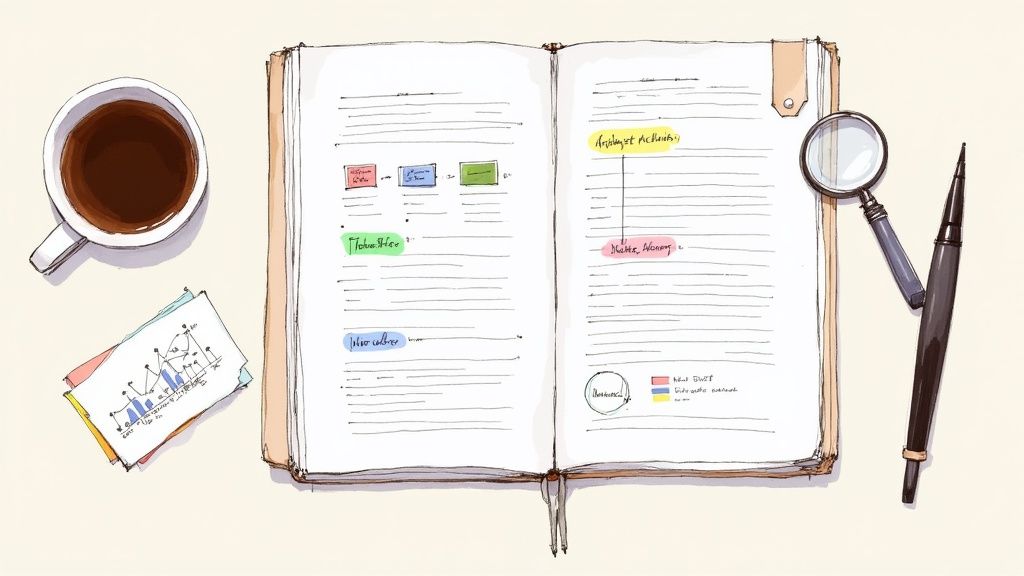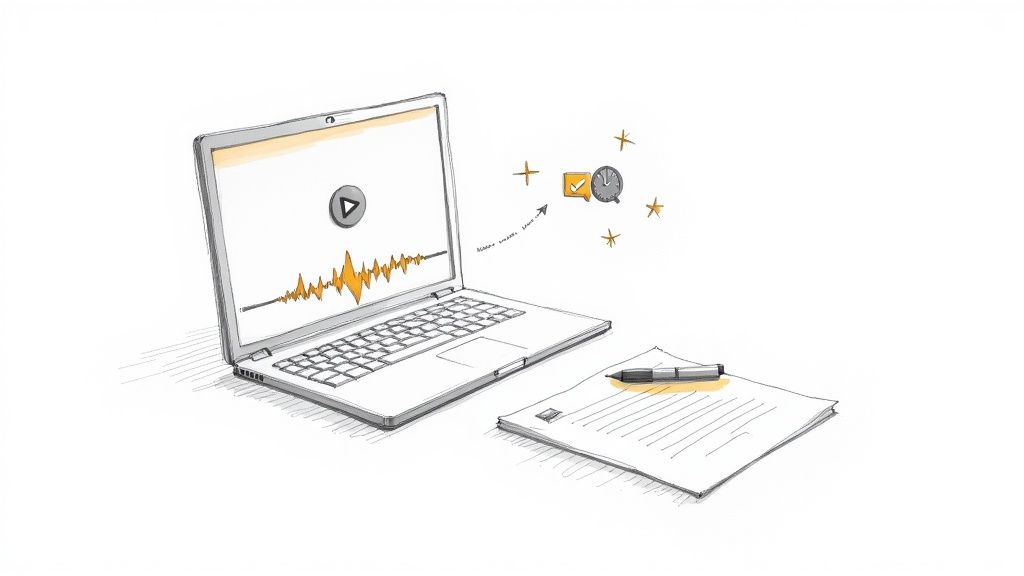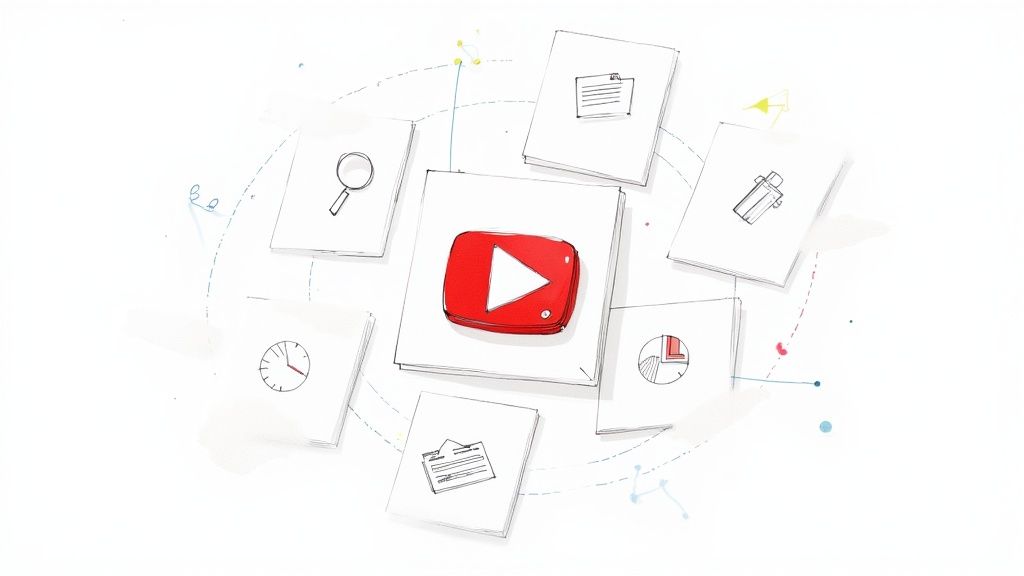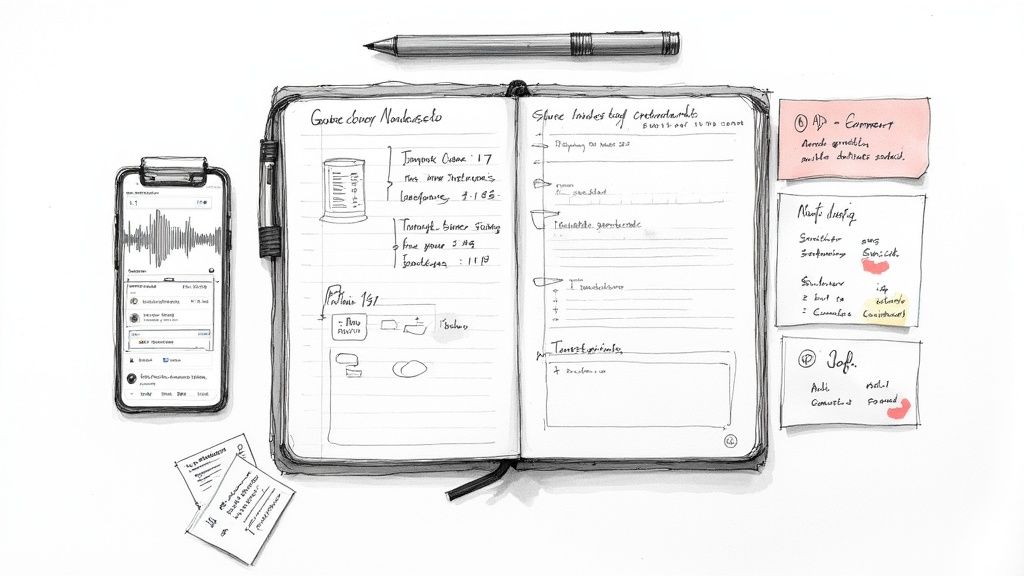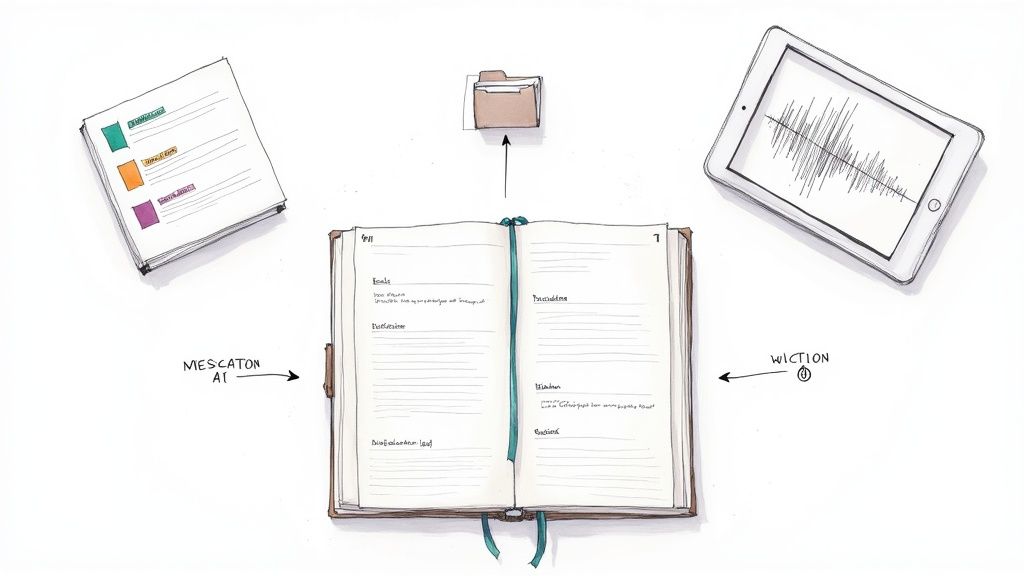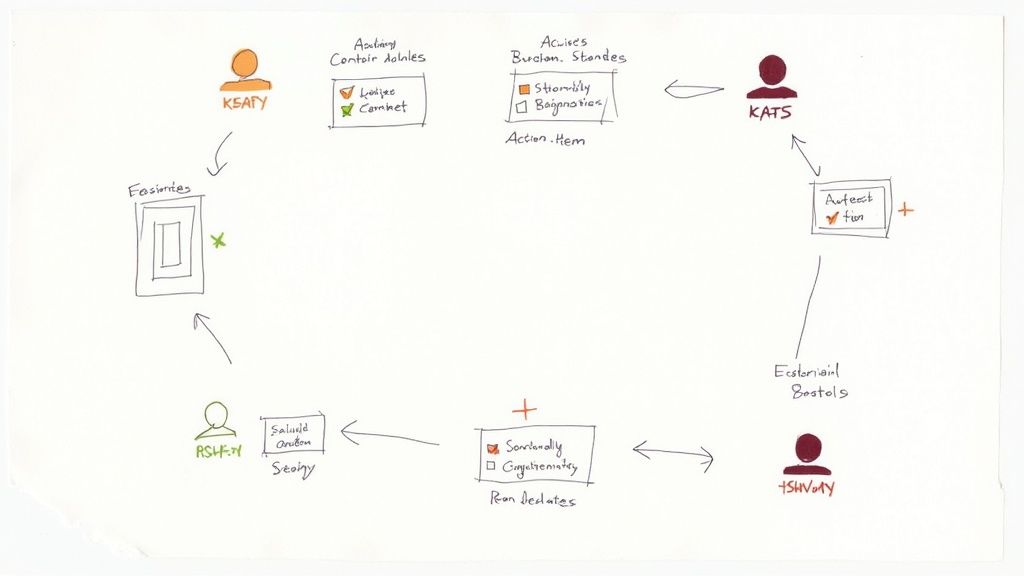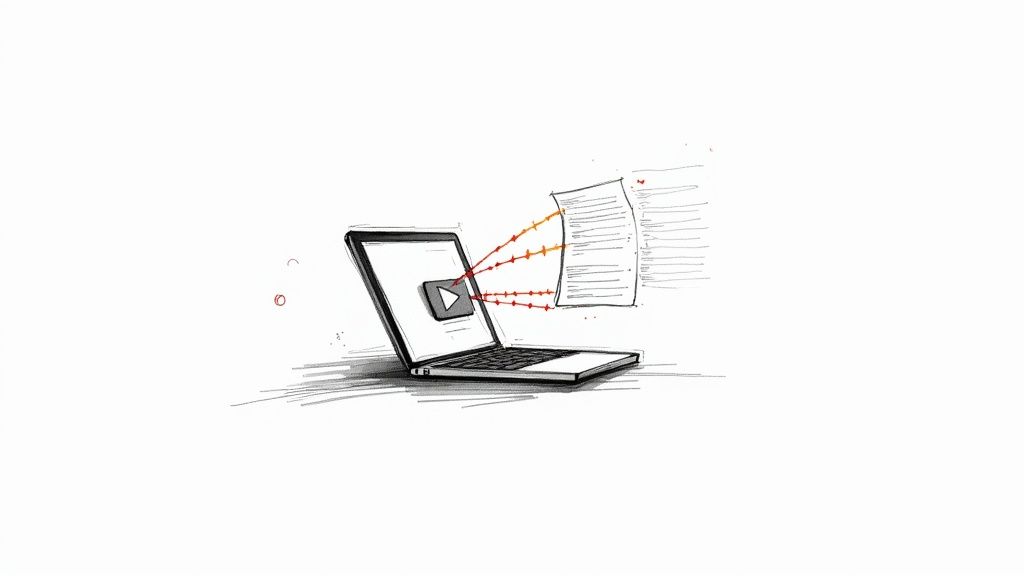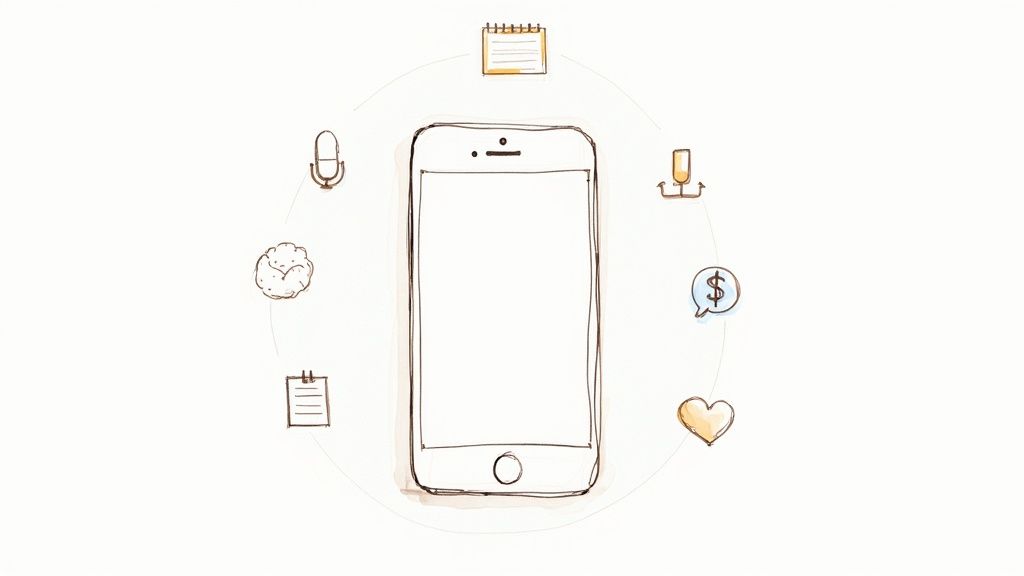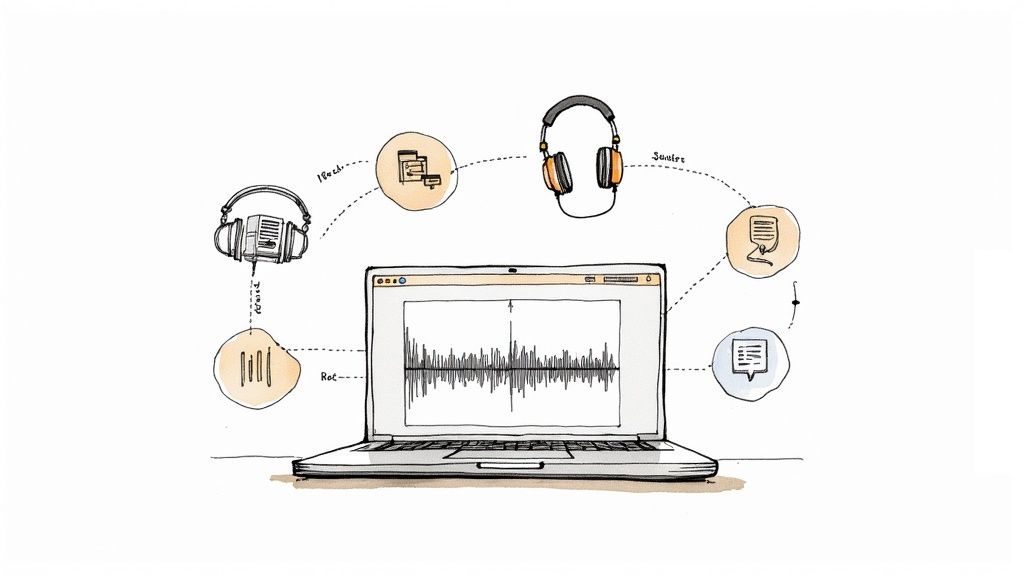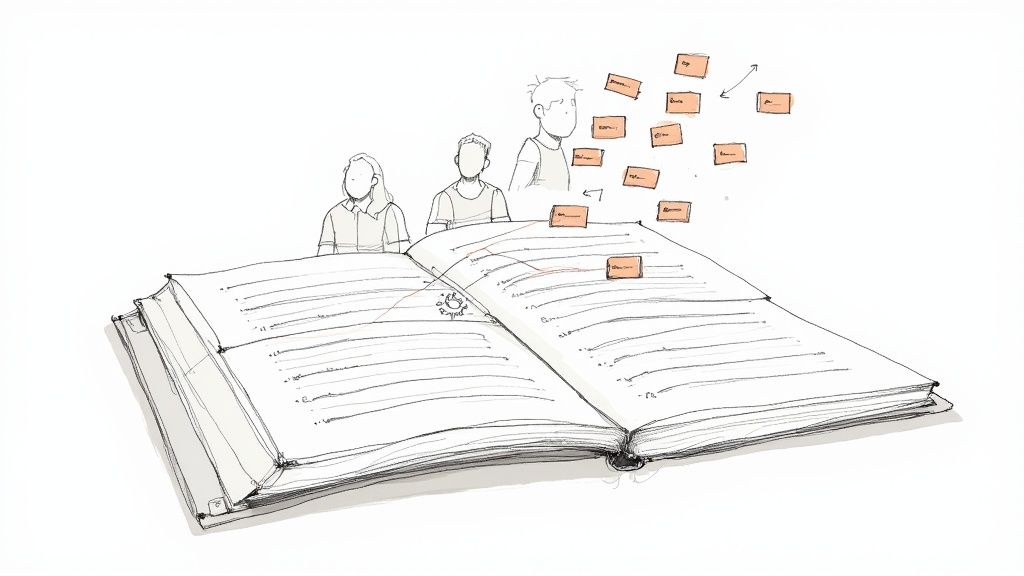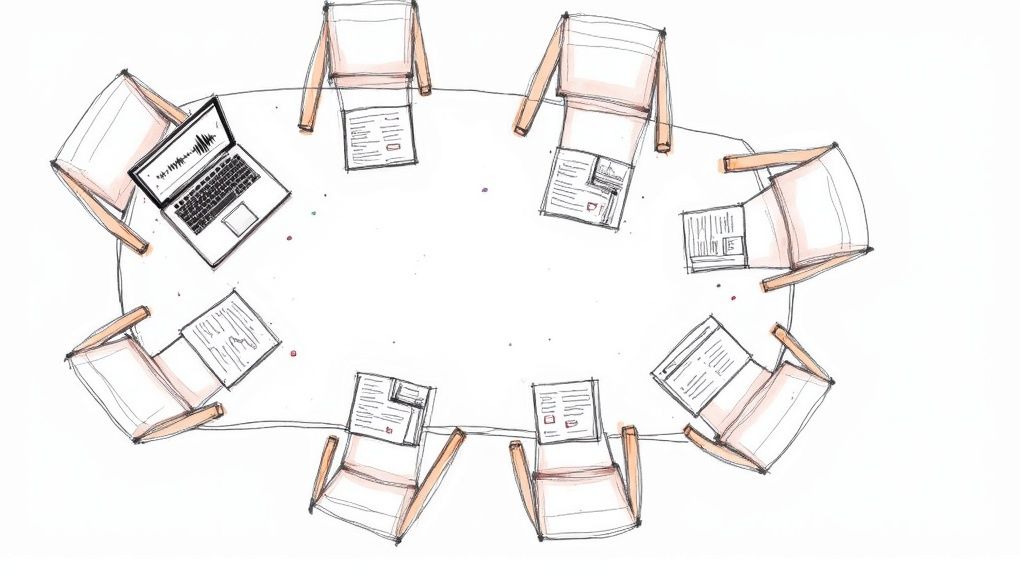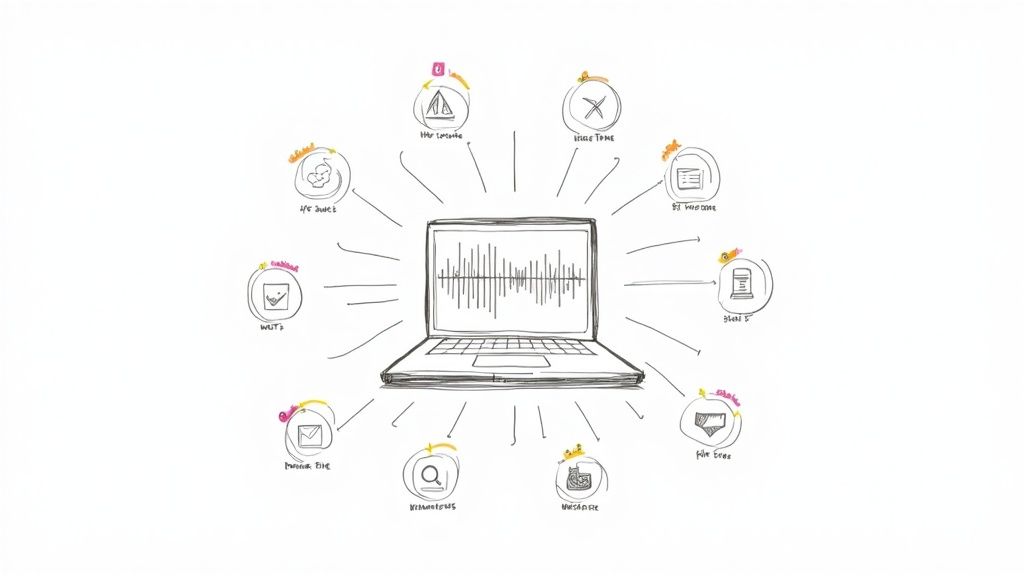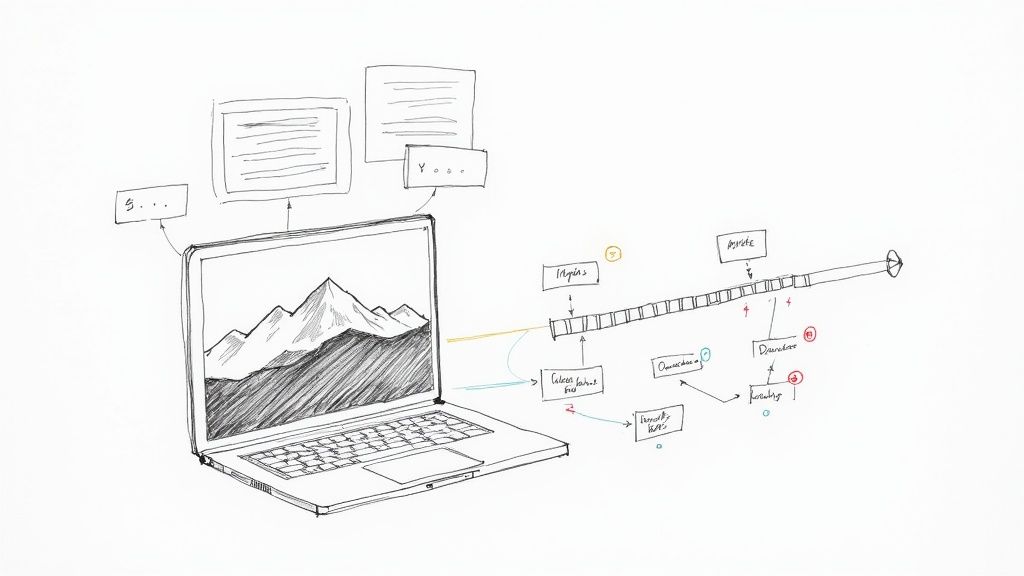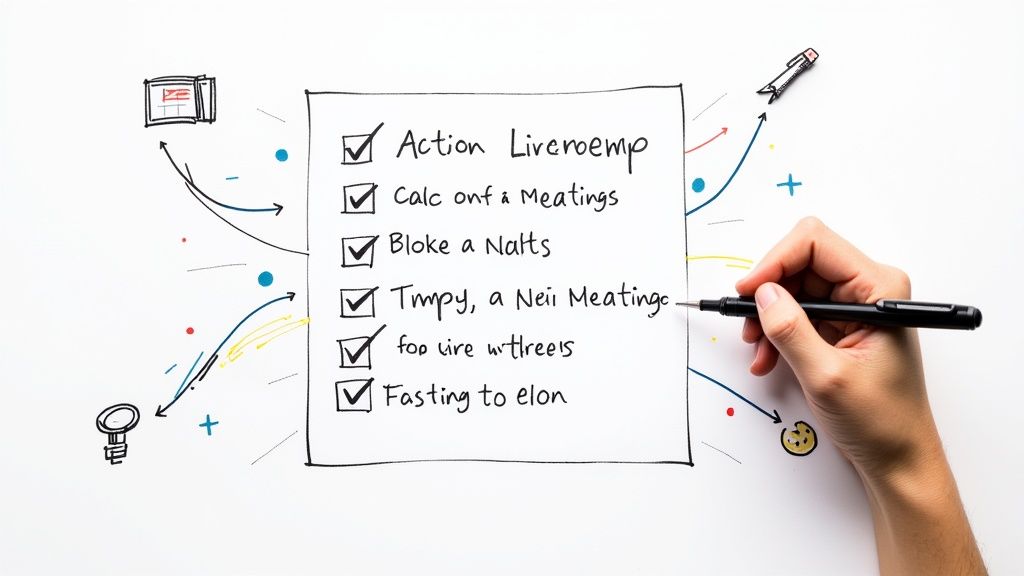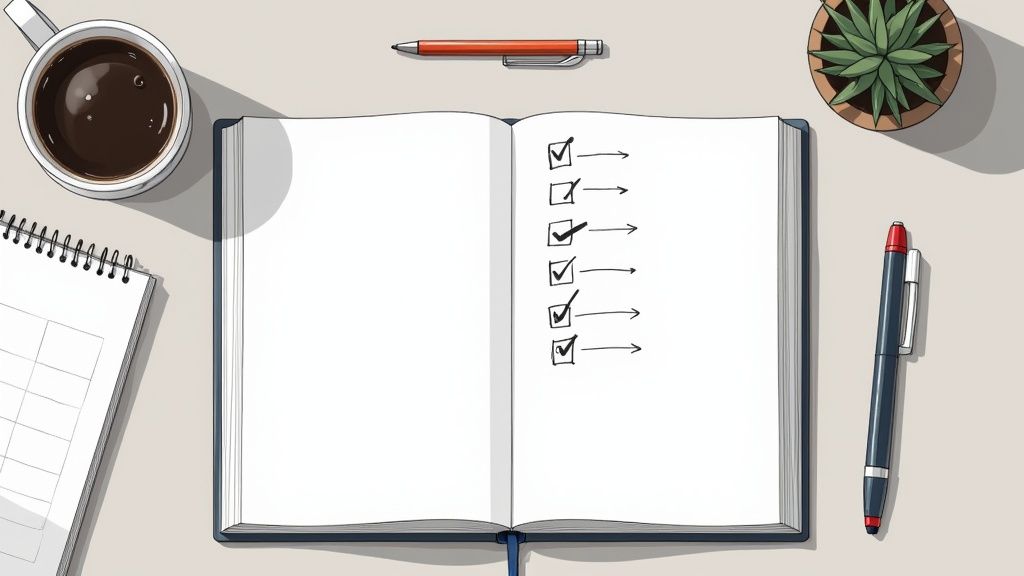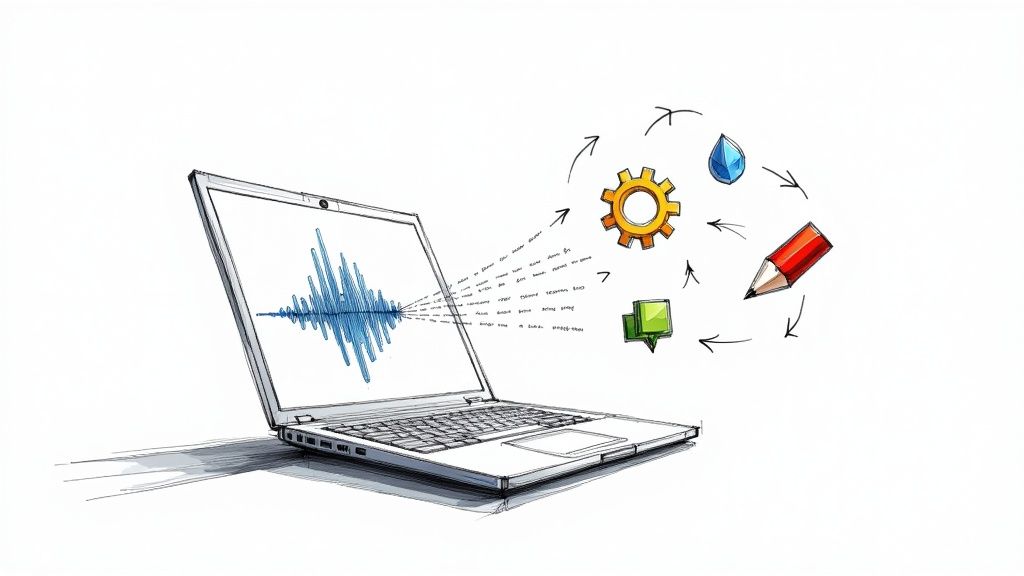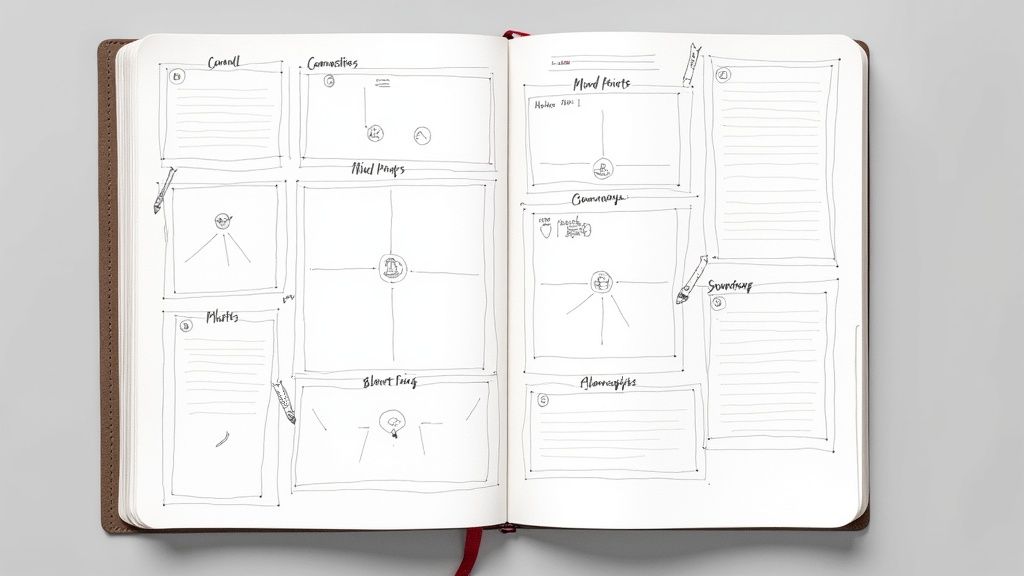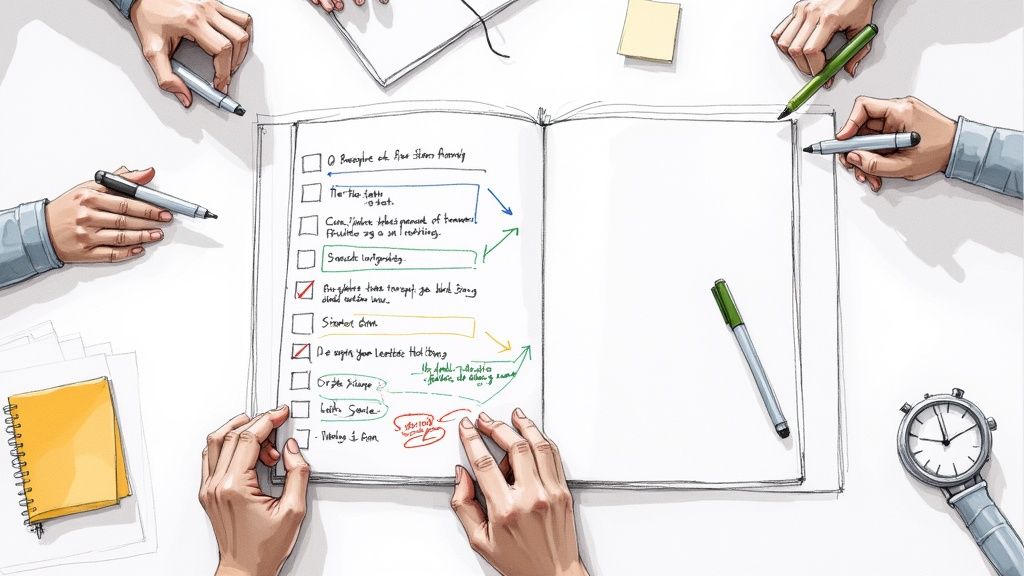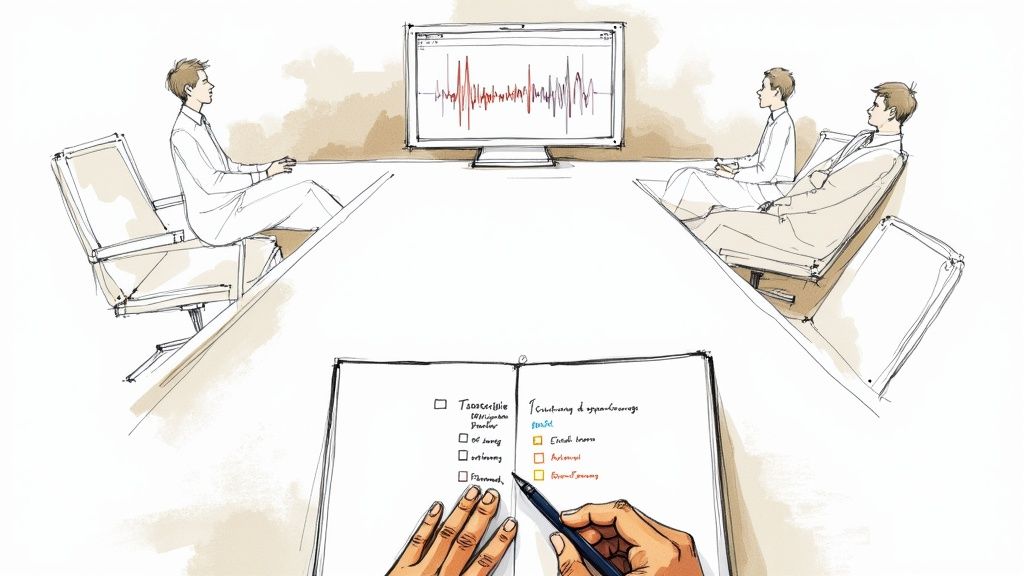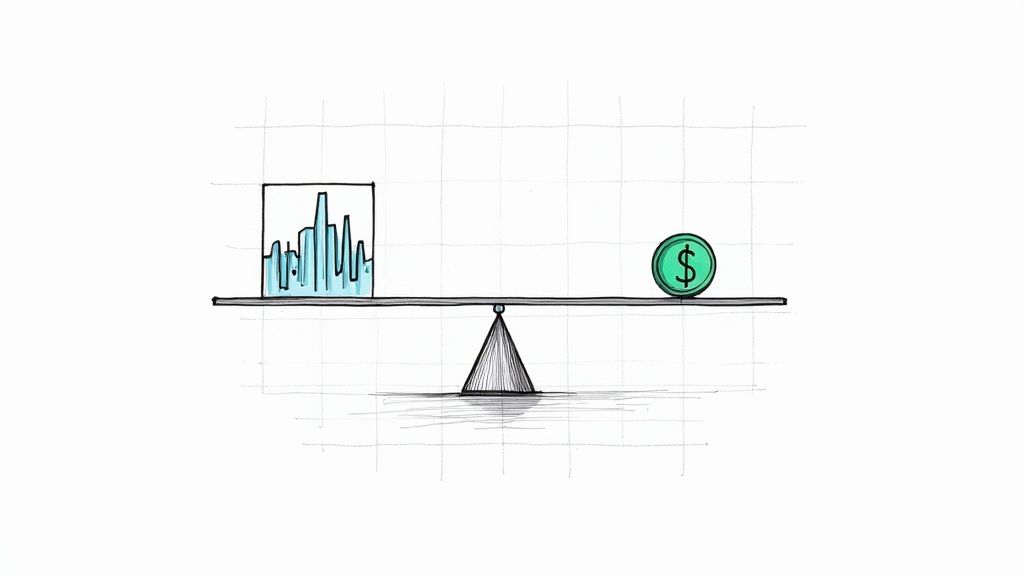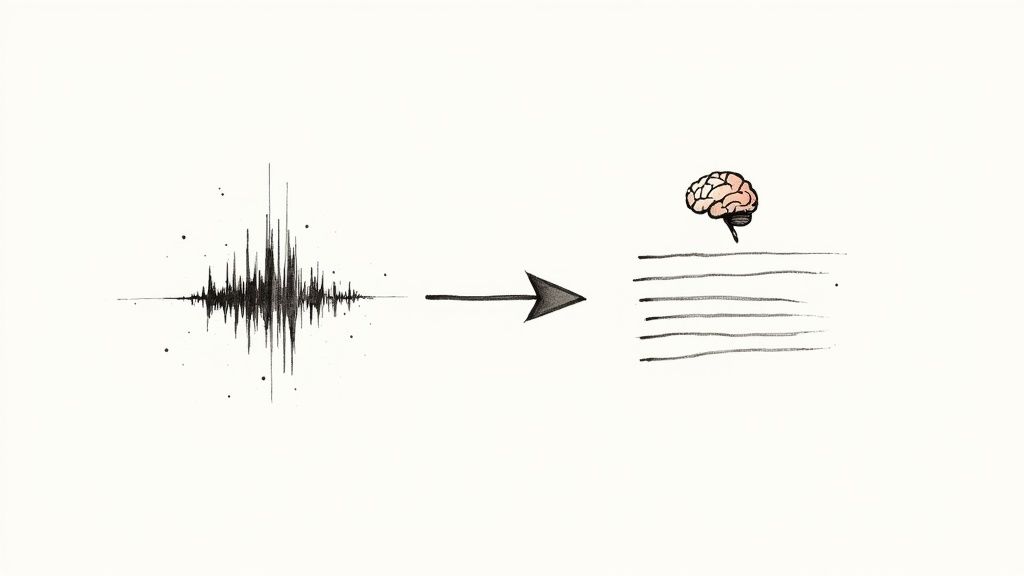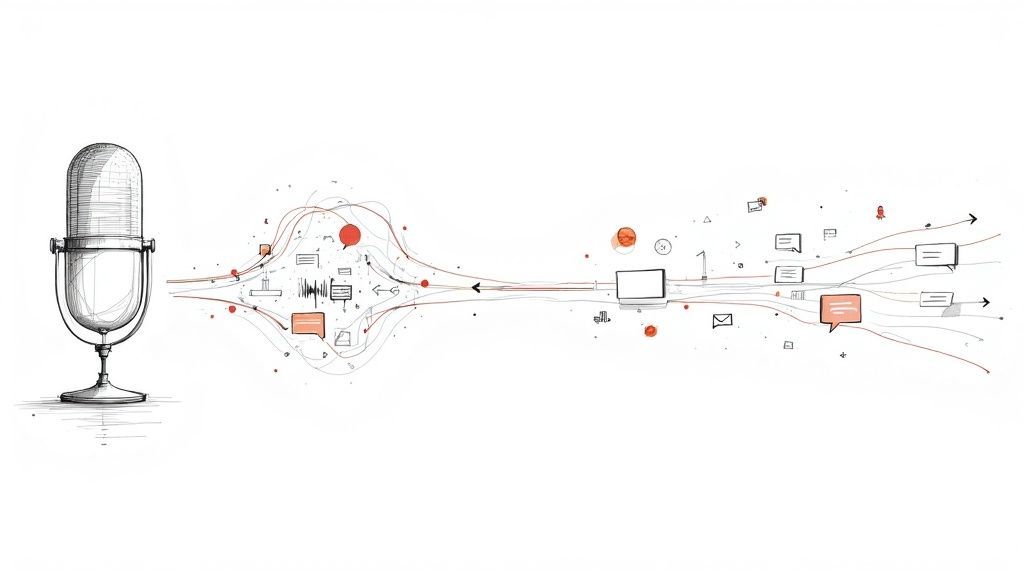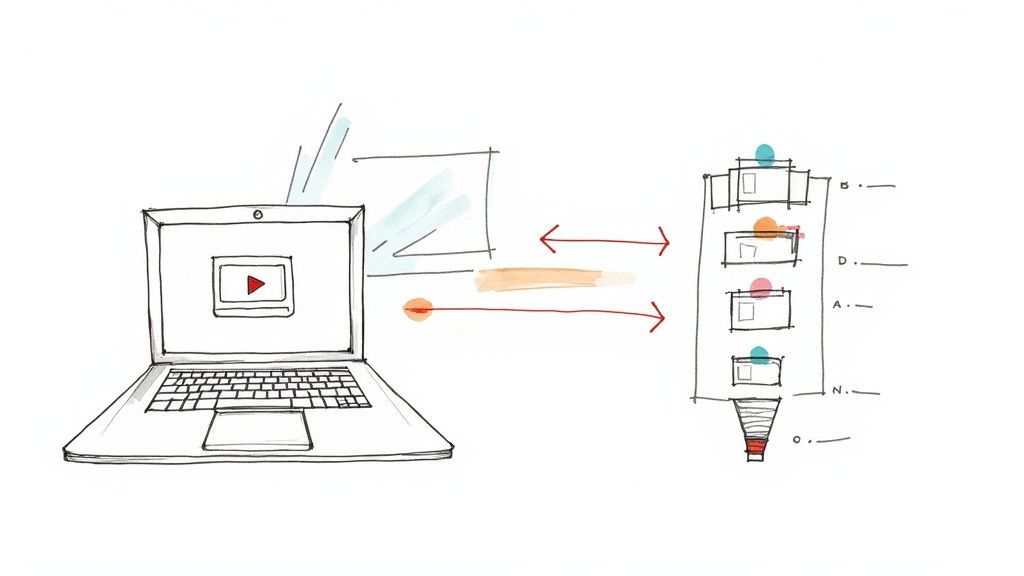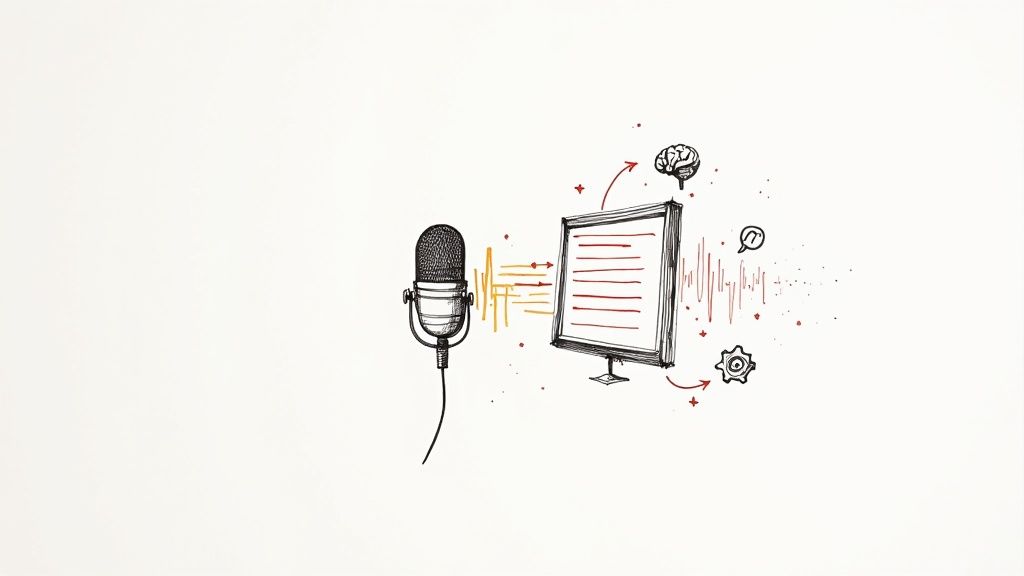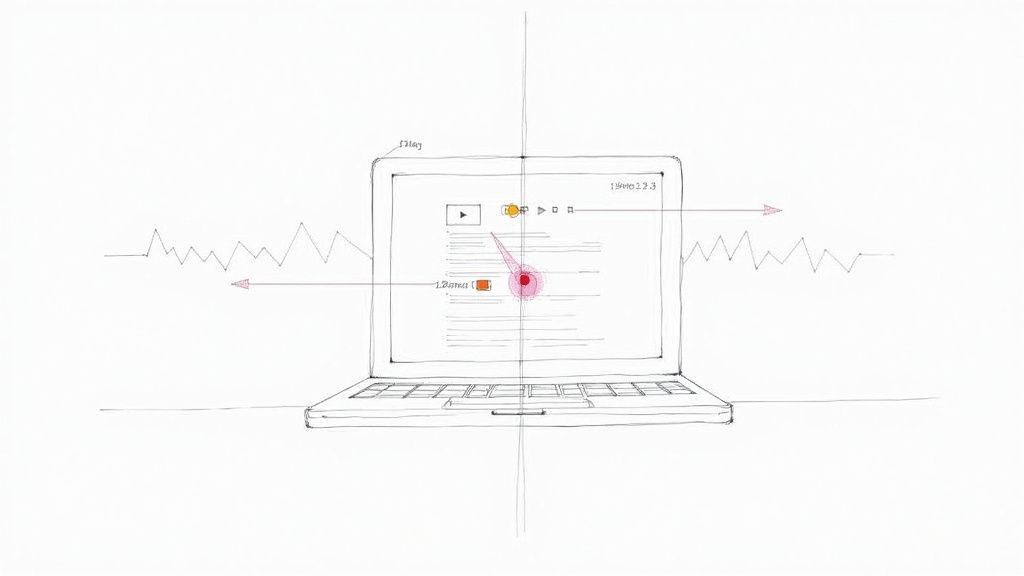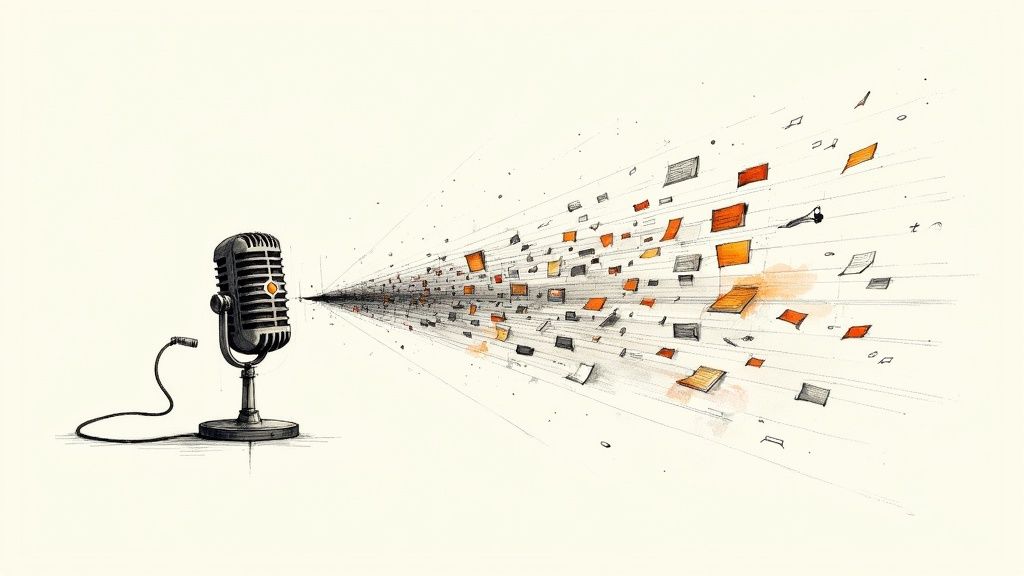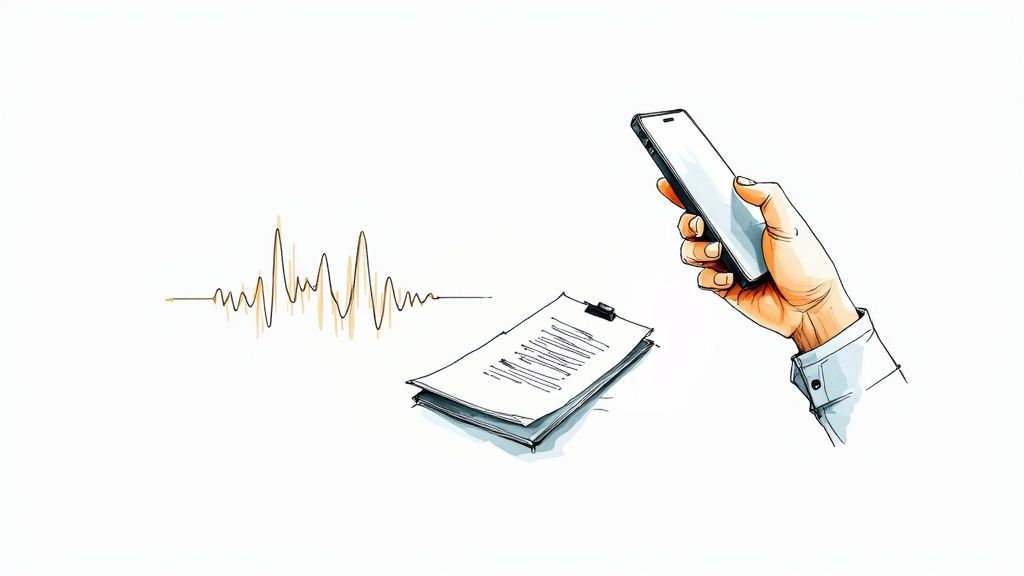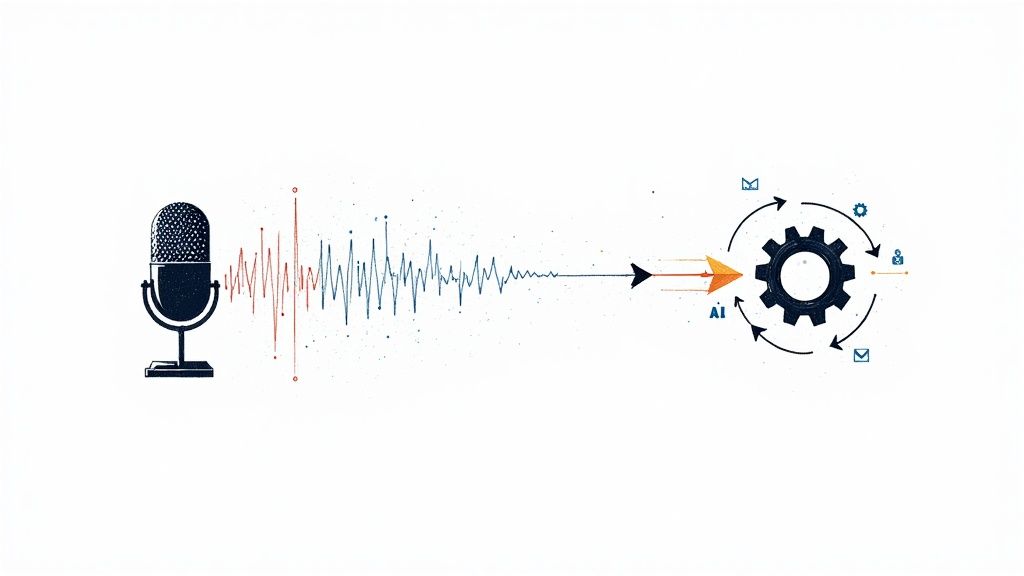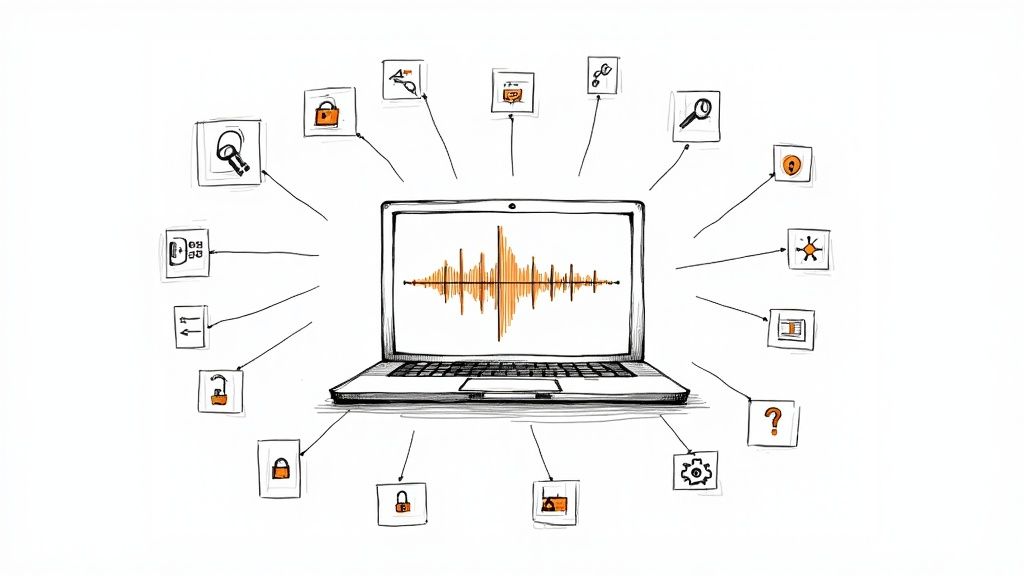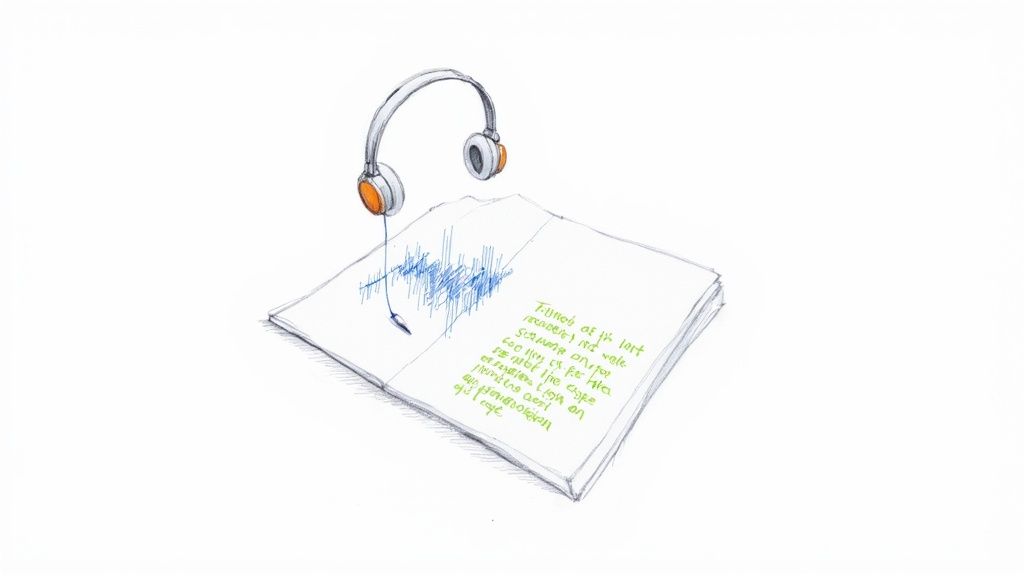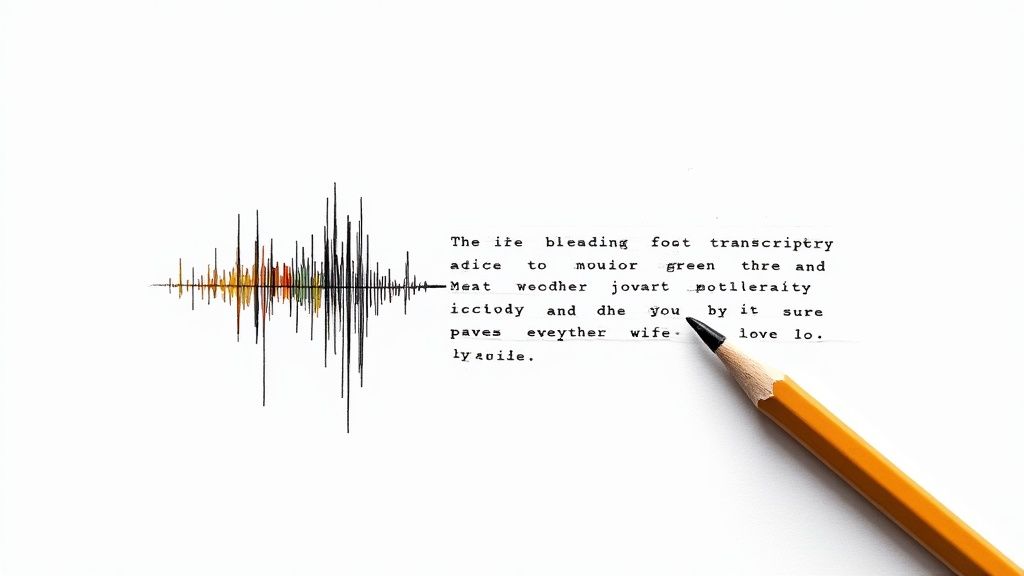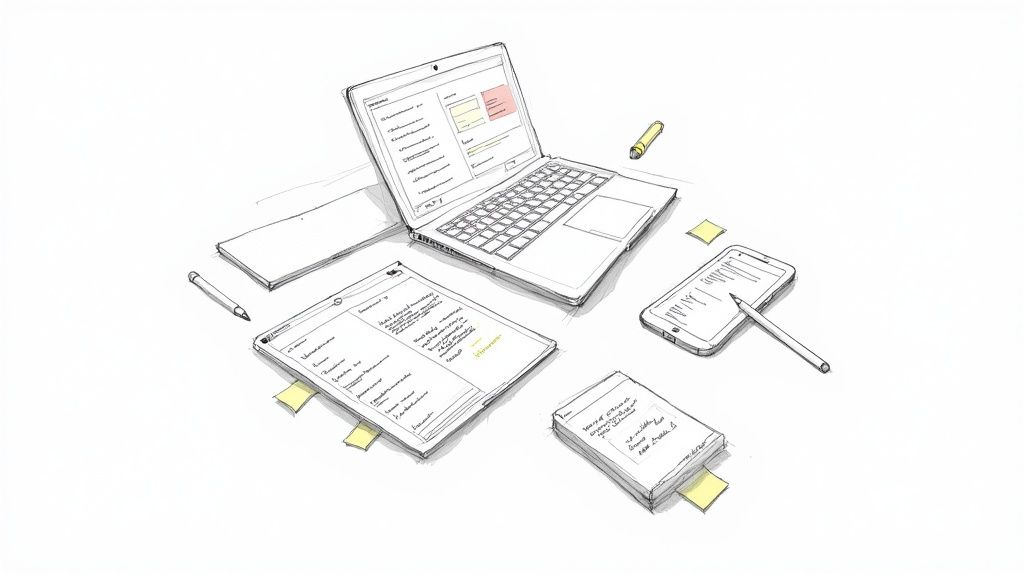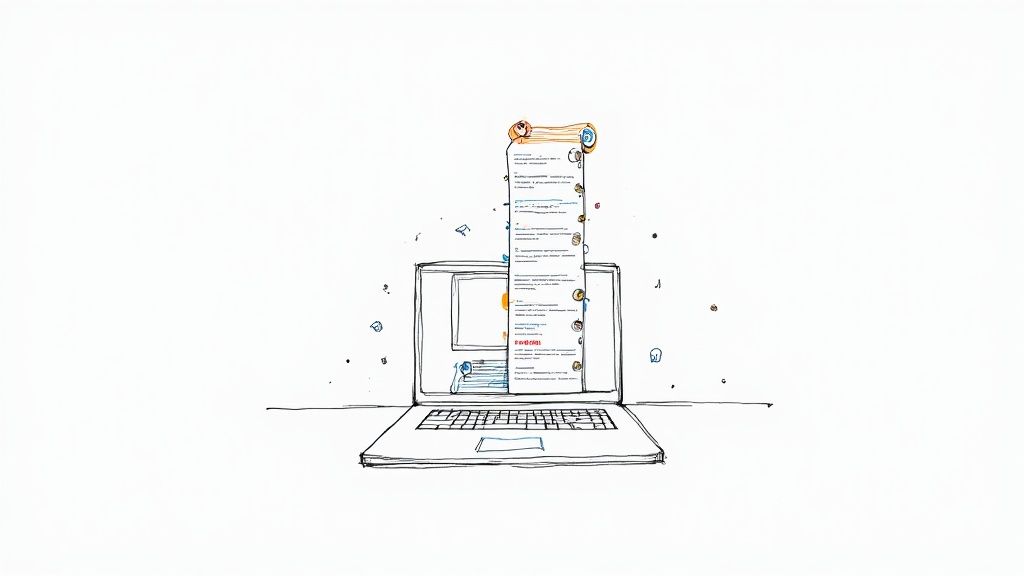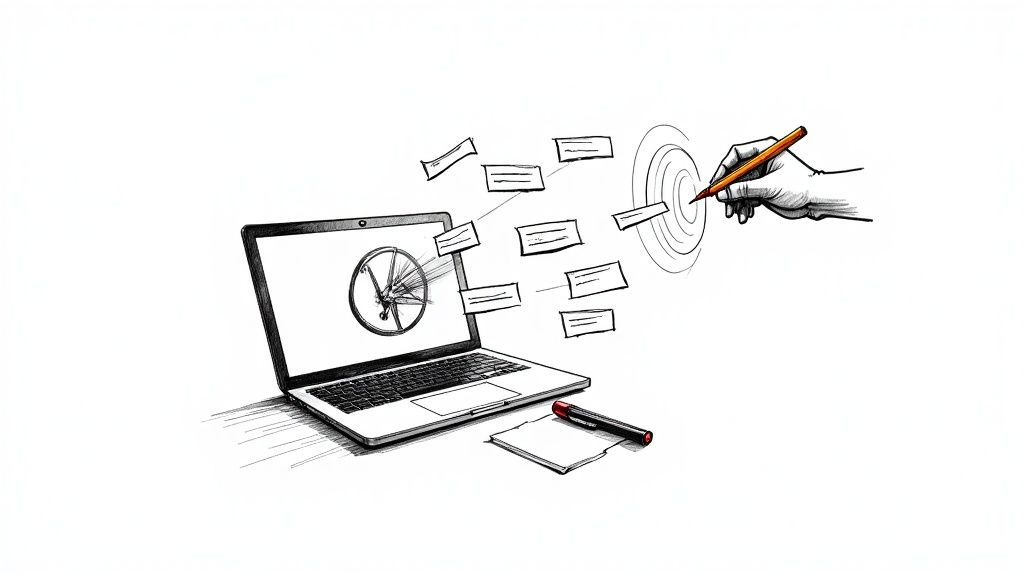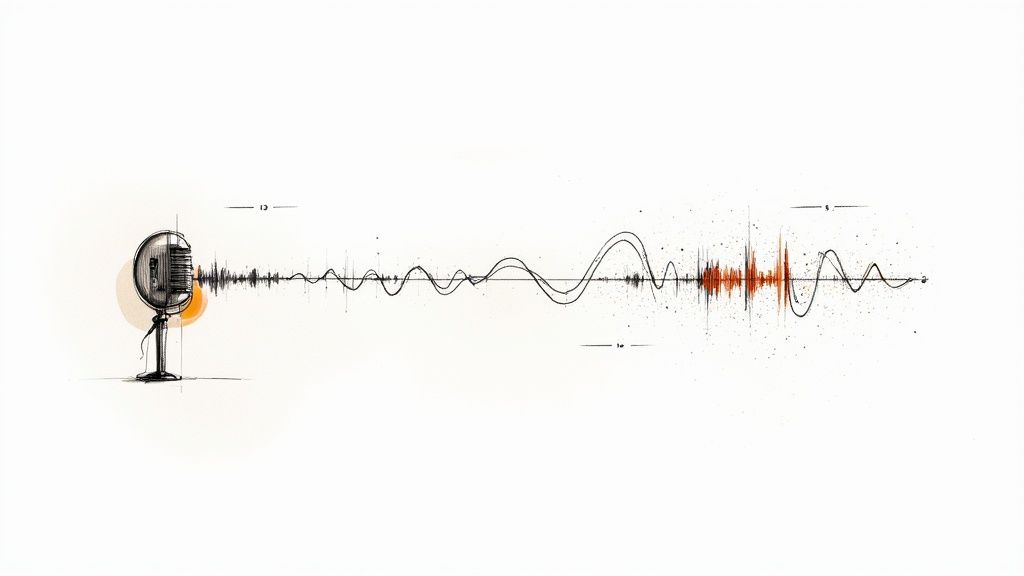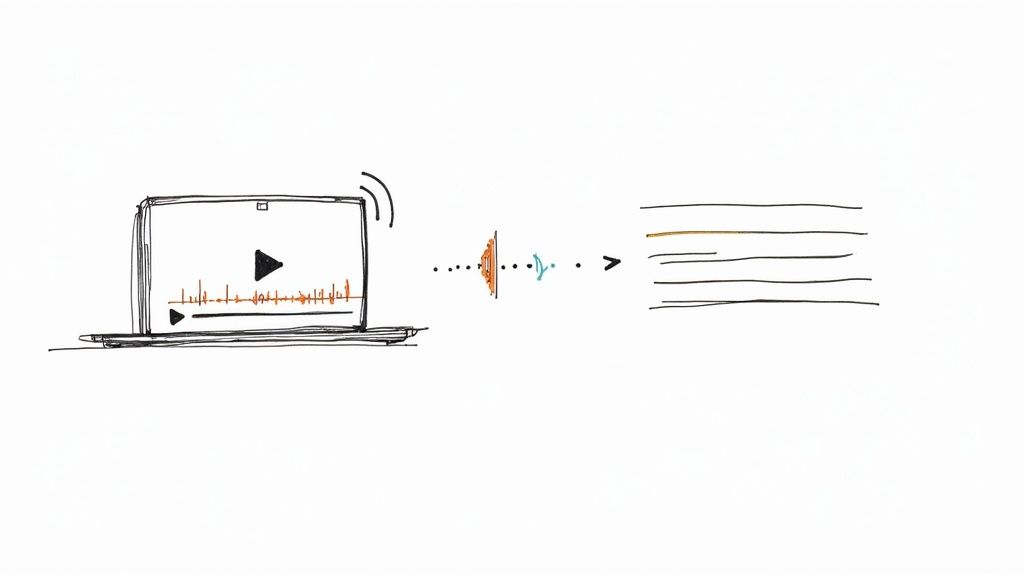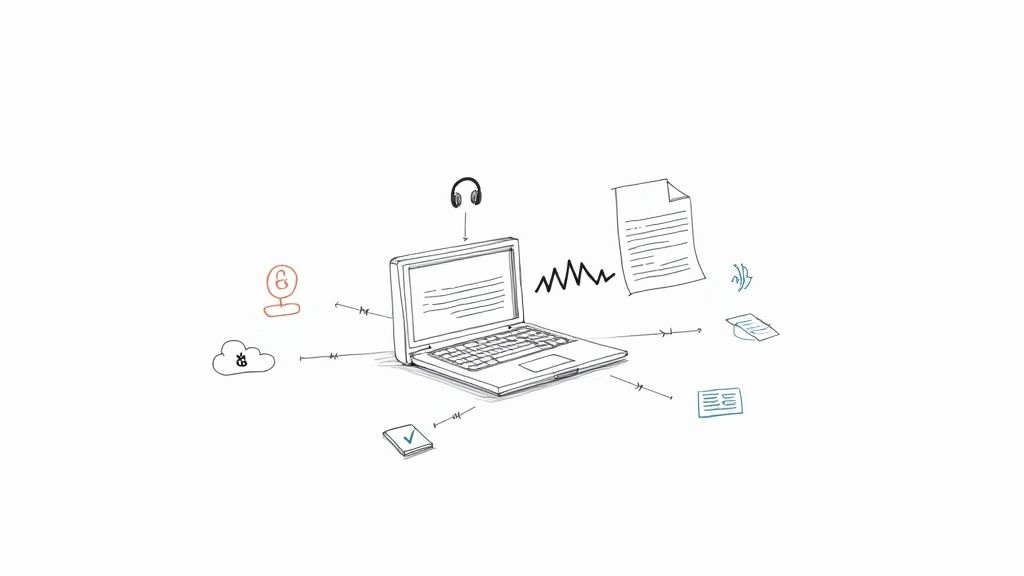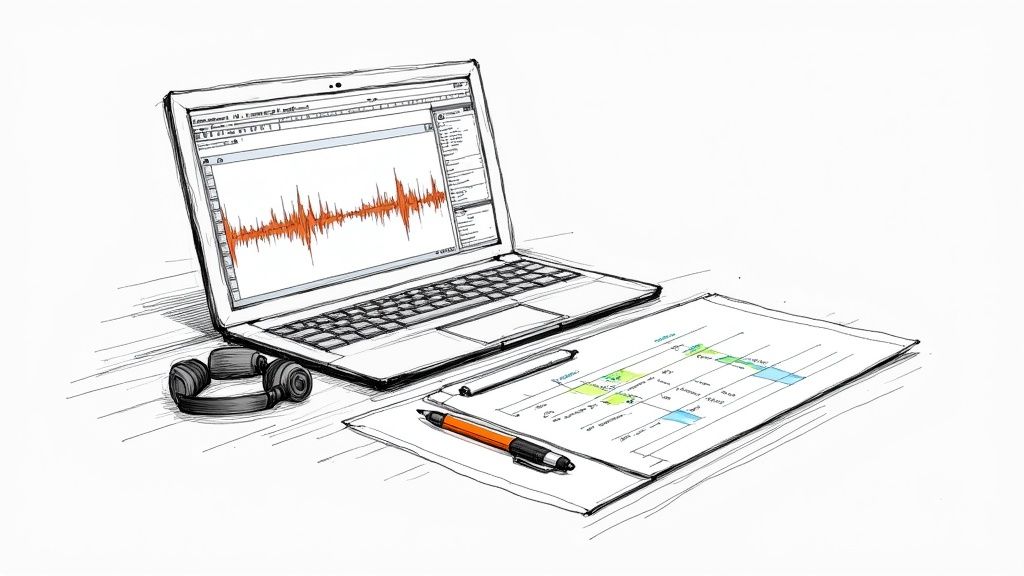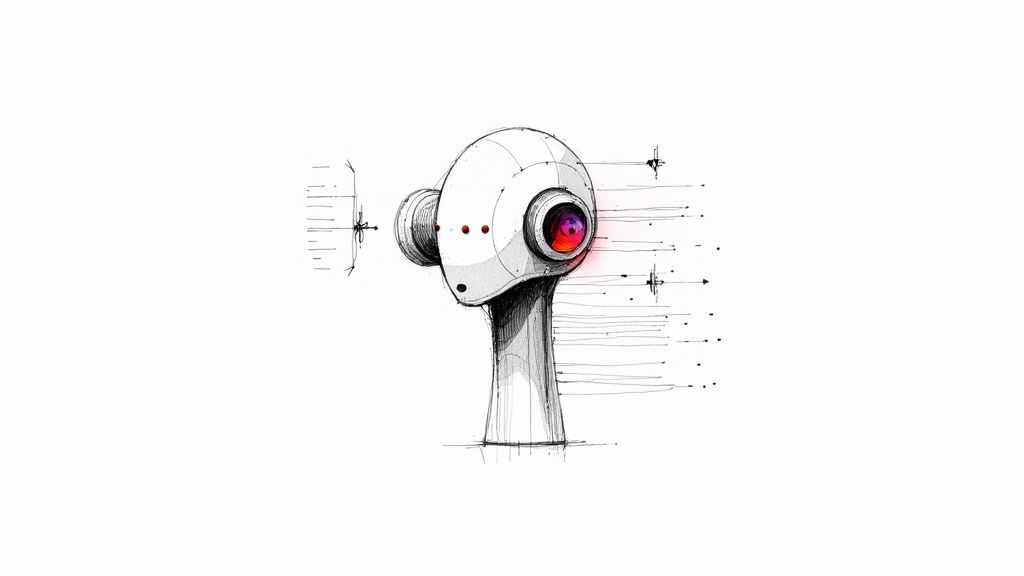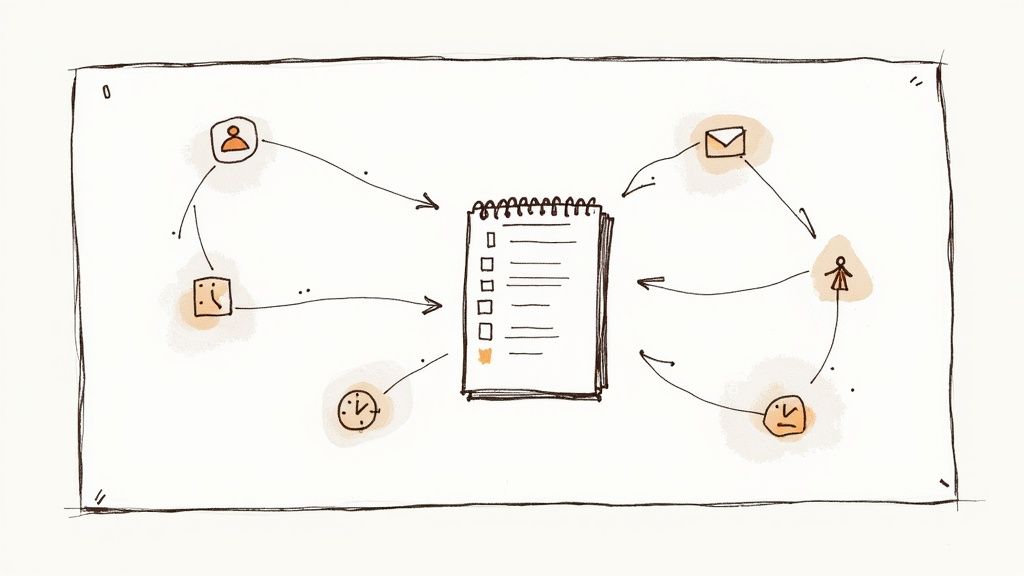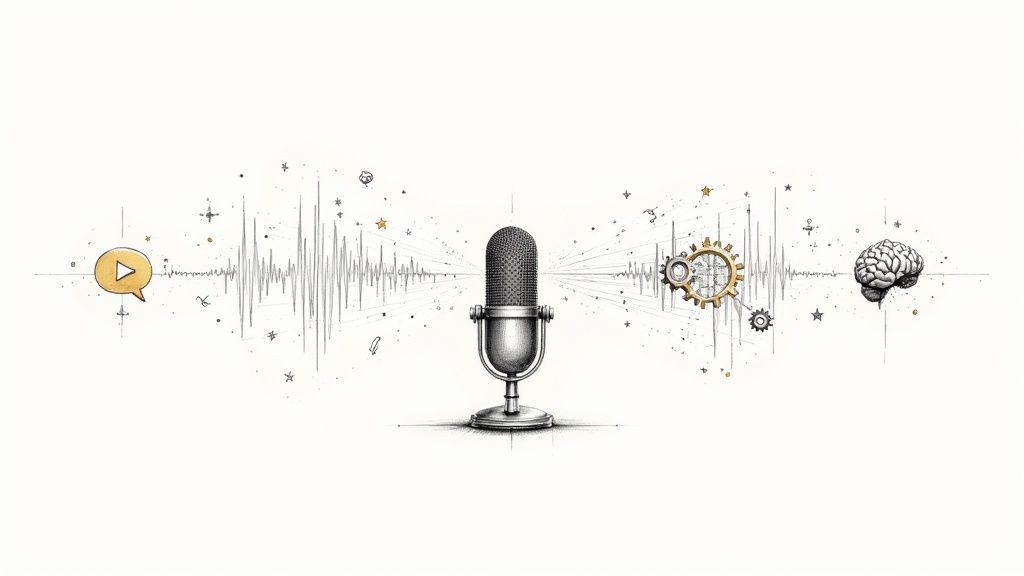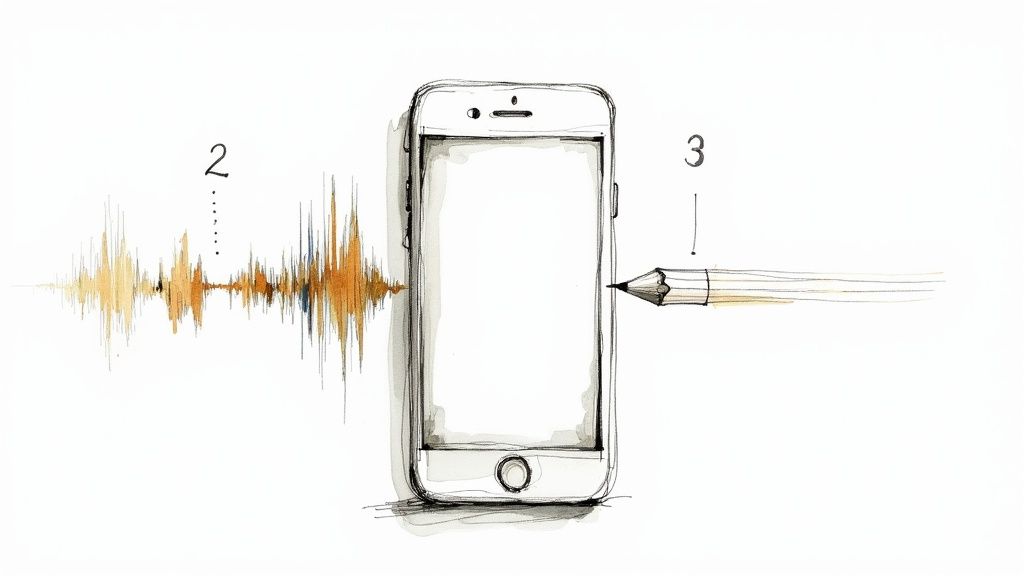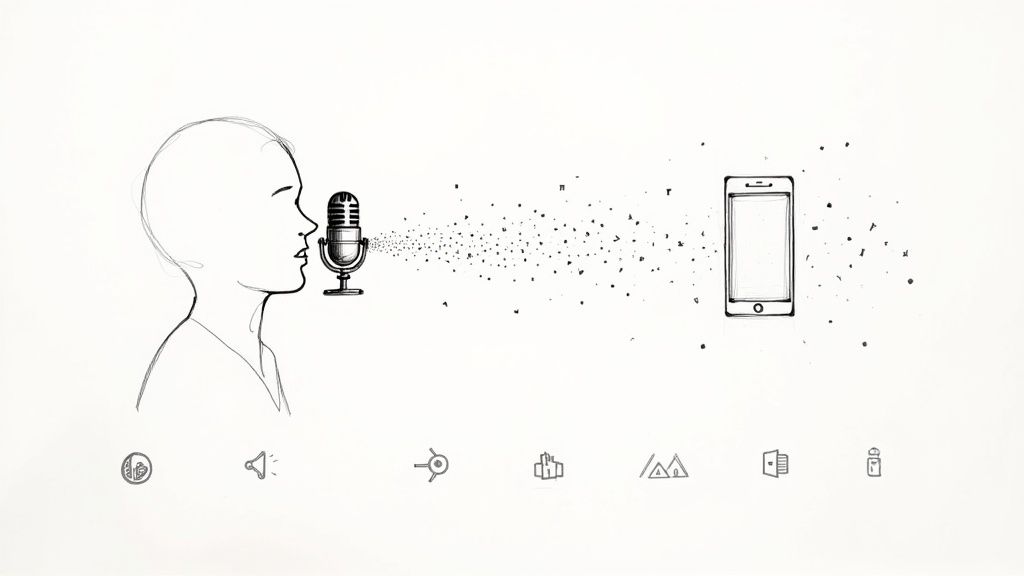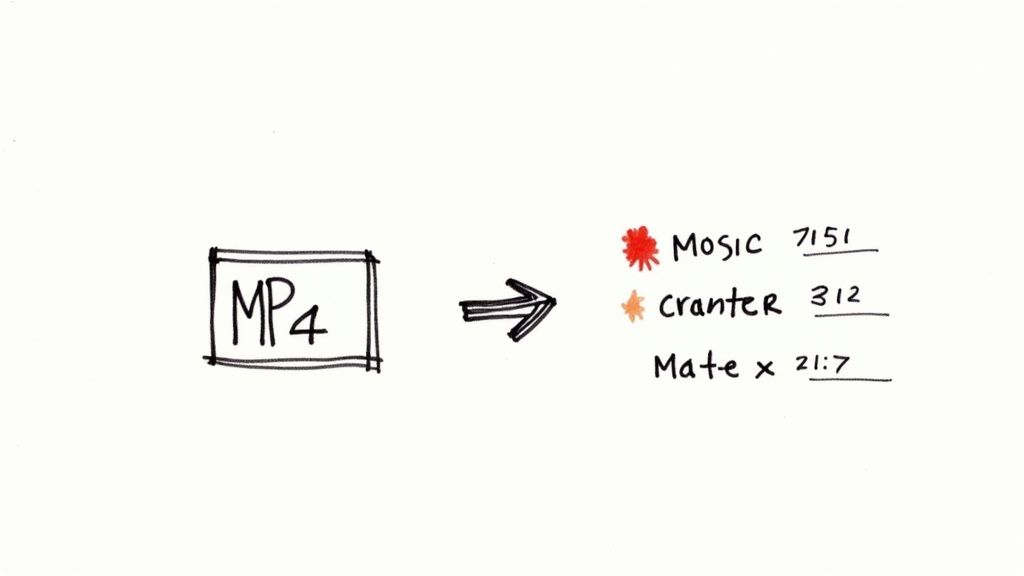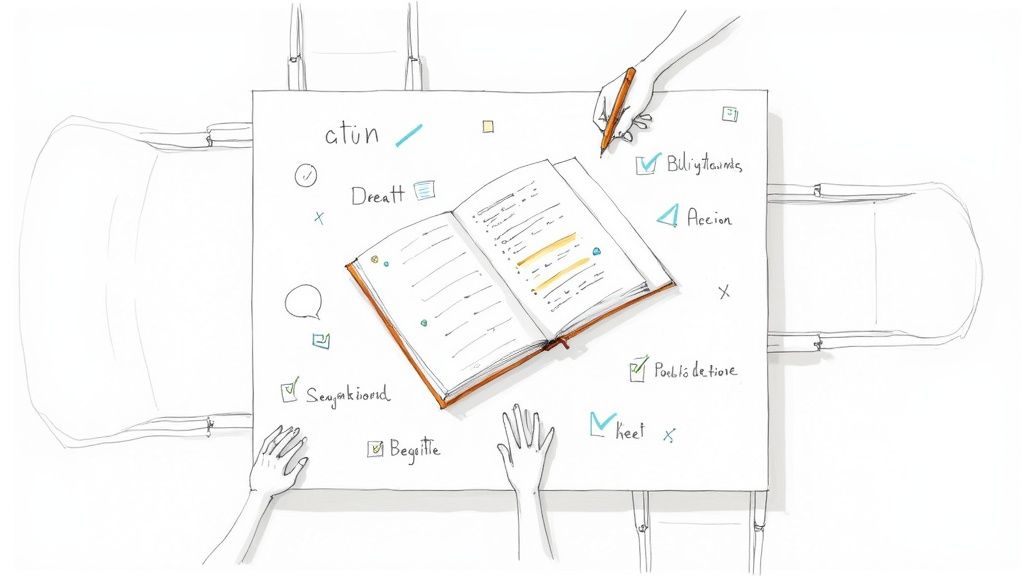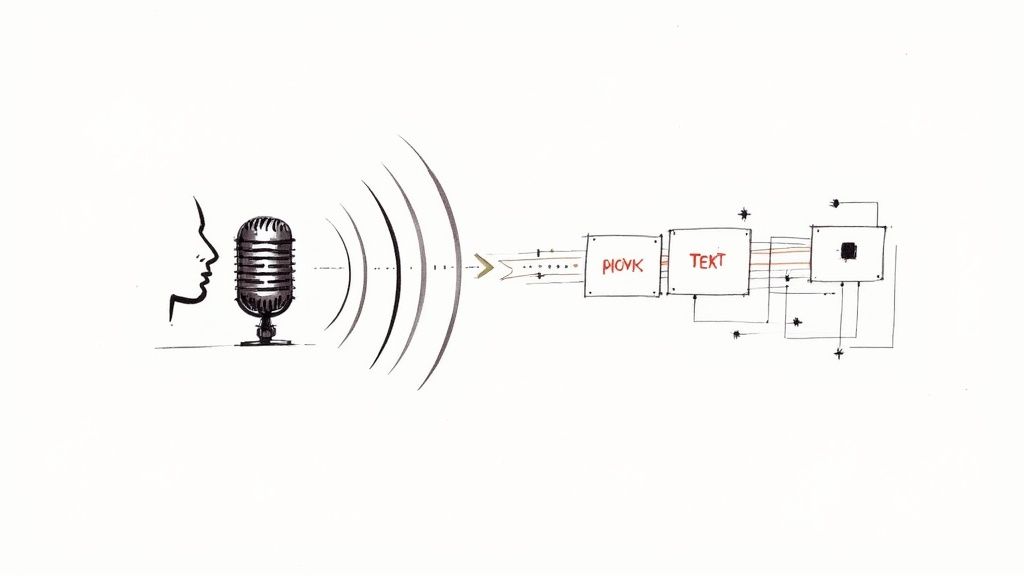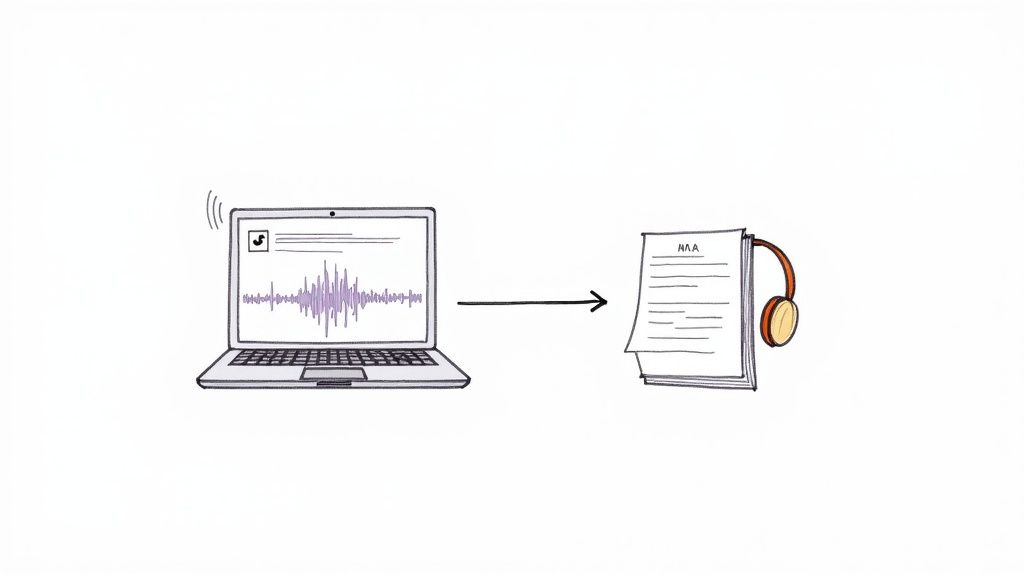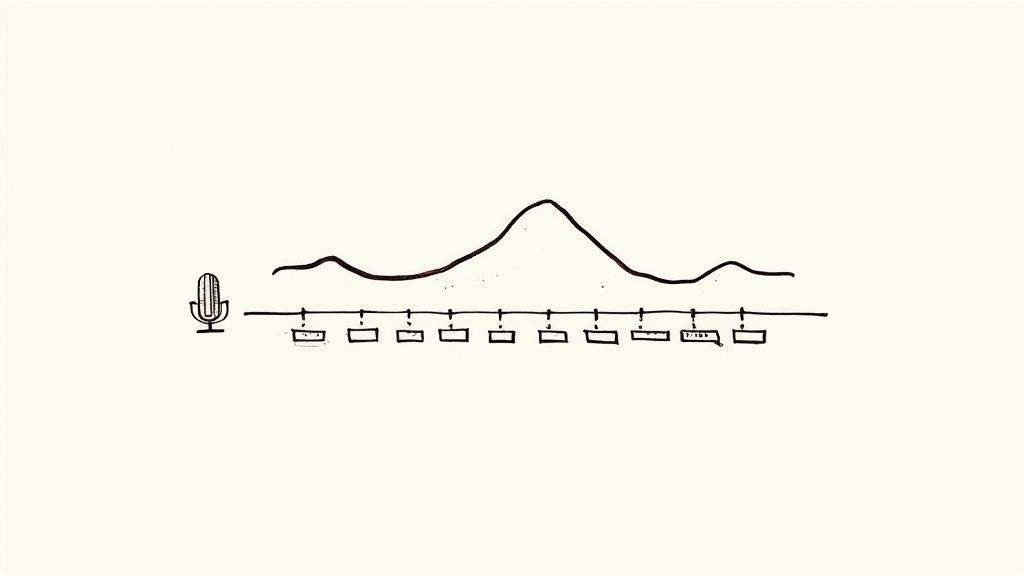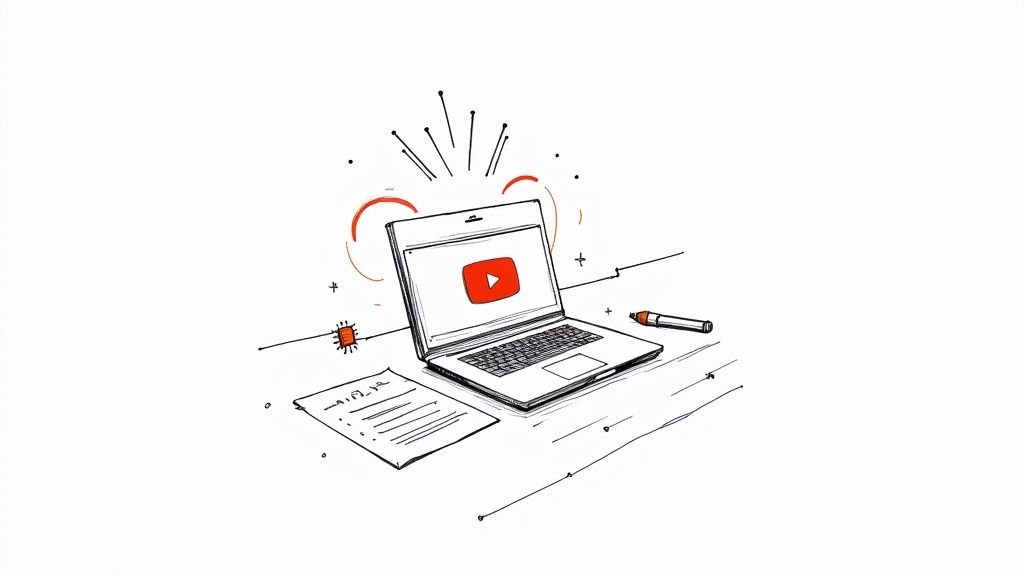
How to Convert Audio to Text: A Practical Guide
When you need to convert audio to text, you have three main paths: doing it by hand, hiring a professional, or using an AI transcription service. From my experience managing countless projects, AI tools consistently offer the best mix of speed, cost, and accuracy for most tasks. They can transform hours of audio into a polished document in minutes, a task that used to take a full day.
Why Converting Audio to Text is an Essential Skill

We live in a world driven by audio and video—podcasts, interviews, team meetings, and webinars are everywhere. The ability to pull spoken words from these files and turn them into searchable text isn't just a convenient trick anymore; it's a fundamental workflow. It’s about making information accessible, searchable, and shareable.
This simple act of transcription unlocks value trapped inside an audio file. As a content creator, I often need to find a specific quote buried in a 90-minute interview. Manually scrubbing through the audio is incredibly inefficient. With a transcript, I can just use Ctrl+F and find it in seconds. This principle applies to students, researchers, marketers, and anyone who works with information.
Unlocking Data and Improving Accessibility
The real power of converting audio to text goes beyond simple note-taking. For businesses, creators, and educators, it's a critical tool for expanding reach and making a bigger impact.
- Boosts Content Discoverability: Search engines like Google can’t listen to your podcast, but they excel at crawling text. Transcribing your audio gives them something to index, opening the door for new audiences to find your content through organic search.
- Enhances Accessibility: Providing transcripts and captions is a game-changer for people who are deaf or hard of hearing. It’s a necessary step toward making your content inclusive for everyone.
- Enables Content Repurposing: A single one-hour webinar can be transformed into a dozen different assets. I regularly turn audio content into blog posts, social media snippets, email newsletters, and infographics, all from one recording. It's a massive time-saver.
- Provides Actionable Business Insights: Companies I've worked with transcribe customer support calls and sales meetings to spot trends, identify training opportunities, and refine their strategies. It turns spoken conversations into structured data.
The core idea is simple but powerful: turning sound into words makes information actionable. It transforms passive listening into an active resource you can search, edit, and share.
This isn't just a niche trend; the demand is exploding. The global speech-to-text API market was valued at $1.3 billion in 2019 and is projected to hit over $3.0 billion by 2027. You can read the full research about speech-to-text API market growth to see just how fast this space is moving. This technology is quickly becoming a fundamental part of how we communicate and analyze information.
Which Transcription Method Should You Choose?
So, you need to turn an audio file into text. Before you start, the first critical decision is how you'll do it. This choice impacts everything—your budget, your deadline, and the final quality of the transcript.
There's no single "best" method. The right path depends entirely on your project's needs. Are you transcribing a high-stakes legal deposition where every word must be perfect? Or are you just trying to get the key points from a team brainstorm for your notes? Each scenario calls for a different tool. You have three main options: manual transcription (doing it yourself), using an AI service, or hiring a human professional.
Comparing Speed, Cost, and Accuracy
Let's start with the DIY approach. Transcribing audio by hand gives you absolute control, but it's a huge time commitment. I've done it, and I can tell you that one hour of clear audio can easily take four to six hours to transcribe accurately. It’s only practical for short, critical clips where you need to capture every nuance yourself.
On the other end of the spectrum are professional transcription services. These are the experts you call for complex or sensitive material—think medical dictation, court proceedings, or academic research filled with jargon. They deliver outstanding accuracy, often 99% or higher, but that quality comes at a higher price and typically takes more time.
This is where automated AI transcription has become a game-changer for most people. It hits that perfect balance of speed, cost, and accuracy for everyday tasks. If you're creating meeting summaries, pulling quotes from an interview, or captioning social media videos, AI is almost always the most efficient choice. We break down more of the advantages in our guide to automatic transcription software.
This infographic clearly illustrates the time difference.

As you can see, what takes an AI a few minutes could take a human hours to complete.
Audio Transcription Methods: A Quick Comparison
To help you decide at a glance, here is a simple comparison table. Consider your project's budget, deadline, and how critical flawless accuracy is.
MethodBest ForAverage CostTypical TurnaroundAccuracyManual (DIY)Short clips needing personal control.Your time4-6 hours per audio hourDepends on skillAI ServiceMeetings, interviews, content creation.$0.15 - $0.25 per minute5-10 minutes per audio hour90-98% (with clear audio)ProfessionalLegal, medical, complex files.$1.50 - $5.00+ per minute24-48 hours99%+
Ultimately, the best method is the one that aligns with your goals. For most day-to-day business and content creation needs, AI offers an unbeatable combination of speed and affordability without a major sacrifice in quality.
How to Use an AI Tool for the Best Results

Alright, let's get practical. Using an AI tool is straightforward, but a few simple preparations can dramatically improve the quality of your final transcript. I think of the AI as a brilliant but very literal assistant—the better the source material you provide, the better the result it produces.
From my experience, the quest for a perfect transcript starts long before you click "upload." The single most important factor is audio quality. If you're recording something, get the microphone as close to the speaker as possible. A cheap lavalier mic in a quiet room will produce a better transcript than a high-end studio mic in a noisy cafe every single time.
Step 1: Prepare Your Audio File
Once you have your recording, a little prep work can significantly boost the AI's accuracy. You don't need to be an audio engineer; just follow these simple steps.
Here’s my pre-transcription checklist:
- Normalize Volume: If you have multiple speakers and one is much louder than the other, the AI can struggle. A quick pass through a free tool like Audacity to "normalize" the audio makes a huge difference by evening out the volume levels.
- Choose the Right Format: While MP3s are common, they are compressed. If possible, use a lossless format like WAV or FLAC. This gives the AI more data to work with, which often leads to higher accuracy.
- Trim the Fat: Cut out the small talk at the beginning, long silent pauses, and any sections with loud, disruptive background noise. Feed the AI a clean, focused recording.
These small steps can easily be the difference between a transcript that's 90% accurate and one that's 98% accurate.
Step 2: Transcribe and Review
Now for the easy part. Most modern AI tools feature a simple drag-and-drop interface. This simplicity is a big reason why the global AI transcription market, valued at USD 4.5 billion in 2024, is expected to hit USD 19.2 billion by 2034. You can see more data on the AI transcription market on market.us.
After uploading your file, you'll likely see a few options. Pay attention here. You may be asked to specify the language spoken and, in some cases, the number of speakers. Getting these details right helps the AI apply the correct language model and do a much better job of separating dialogue. Our complete guide on using AI for audio to text dives deeper into these settings.
The most crucial step—and the one most people skip—is the final review. Never treat the first AI-generated draft as the final copy. A quick proofread while listening to the audio will catch 99% of the mistakes.
Common errors I often see are misspellings of unique names, confusion around industry-specific jargon, or simple homophone mistakes like "their" vs. "there." My process is to read through the text while listening to the original audio at 1.5x speed. This allows me to quickly spot and fix minor errors, transforming a good transcript into a perfect one.
Using Whisper for Private, Offline Transcription
Online AI transcription services are fantastic, but they require you to upload your audio to a third-party server. What if the material is sensitive? Think confidential interviews, private company meetings, or proprietary research. In these cases, sending your data to the cloud simply isn't an option due to privacy concerns.
This is where OpenAI's Whisper is an excellent solution. Because it's an open-source model, you can download and run it entirely on your own computer. Your audio files never leave your machine, giving you absolute privacy and control. It's a powerful option for anyone handling sensitive information.
How to Get Whisper Running on Your Computer
The idea of running an AI model locally might sound intimidating, but it's more accessible than you might think. The main prerequisite is having Python installed on your computer. With that set up, you can install Whisper with just a single command in your terminal.
Once installed, transcribing a file is as simple as typing this:
whisper "your_audio_file.mp3"
That one command tells Whisper to process your audio and output the text directly in the terminal. You get world-class transcription right on your desktop, completely free and with no subscription fees.
As shown in OpenAI's research data, Whisper's accuracy is impressive across a wide range of languages, often outperforming commercial alternatives.
The chart highlights how Whisper significantly reduces word error rates, making it a reliable choice even for non-English audio.
Choosing the Right Whisper Model for Your Needs
Whisper comes in several sizes, from tiny to large. The model you choose involves a trade-off between speed and accuracy.
- Tiny & Base Models: These are the fastest and require the least computing power, making them perfect for older machines or when you just need a quick, rough transcript.
- Small & Medium Models: This is the sweet spot for most users. They offer a significant accuracy boost over the smaller models without needing a high-end computer.
- Large Model: This is the most accurate model available. It provides the best results but runs much slower and benefits greatly from a powerful computer, especially one with a dedicated graphics card (GPU).
My advice? Start with the base or small model. Run a test on a short audio clip to see how it performs on your hardware. From there, you can decide if you need to move to a larger model for better accuracy.
How to Edit Your Transcript for a Professional Finish

Getting that first raw AI transcript is a huge time-saver, but it's just the first draft. The real magic happens during the editing phase, where you transform that raw text into a polished, professional document that's both accurate and easy to read.
Over the years, I've developed a workflow that turns a decent transcript into a truly useful one. It's less about fixing typos and more about adding structure and clarity that audio alone can't provide.
My Post-Transcription Editing Checklist
To elevate your transcripts, focus on organization and readability. If your recording has multiple speakers, using clear speaker labels (Speaker 1, Jane Doe, etc.) is non-negotiable. This simple step instantly clarifies who is speaking and makes dialogue easy to follow.
Timestamps are another game-changer, especially for long interviews or meetings. They act like bookmarks, allowing readers to jump to a specific moment in the audio. If you want to get really precise, our guide on transcription with timecodes shows you how to sync your text and audio perfectly.
Here’s a pro tip that saves me a ton of time: Before I start editing, I create a quick glossary. I jot down any unique names, company-specific jargon, or technical terms mentioned in the audio. Having this cheat sheet handy makes spotting and correcting AI errors much faster.
Formatting for Readability and Impact
The final presentation is just as important as the words themselves. No one wants to read a dense wall of text.
- Break It Up: Use short paragraphs of just a few sentences each. This gives the reader’s eyes a break and improves comprehension.
- Use Headings: Organize the content into logical sections with clear headings and subheadings. This makes the document scannable, so people can quickly find what they need.
- Emphasize Key Points: Use bold text or bullet points to highlight important quotes, key takeaways, or action items.
This level of detail is becoming the professional standard. The speech recognition market, which powers the tools we use to convert audio to text, is expected to hit USD 25.0 billion by 2025. You can discover more insights about speech and voice recognition market growth on scoop.market.us. Taking these extra formatting steps ensures your work is not just accurate, but truly valuable to the reader.
Your Top Audio Transcription Questions Answered
Even with the best tools, you likely have questions before you start converting audio to text. Based on my experience, here are the answers to the most common ones I hear.
Getting these cleared up will help you start your project with confidence.
How accurate is AI transcription? What file format is best?
This is the most common question. Today's AI models are incredibly accurate, often achieving over 95% accuracy on clear recordings. For most business needs—like transcribing meeting notes or interviews—this is more than sufficient. However, a professional human transcriber still has the edge for challenging audio, consistently reaching 99% accuracy or higher by understanding context, accents, and overlapping speakers in a way AI sometimes can't.
For the best possible results, use a lossless audio format like WAV or FLAC. These uncompressed formats provide the AI with the maximum amount of audio data to analyze. While compressed files like MP3s are convenient and usually work fine, they can sometimes lose subtle sounds that impact accuracy.
Remember, the quality of your source audio is the single biggest factor in transcription accuracy. A clear recording in a lossless format will almost always yield a near-perfect result from a good AI tool.
How much does transcription cost? And how long does it take?
It's absolutely possible to convert audio to text for free. Tools you may already use, like the voice typing feature in Google Docs, are great for live dictation. For pre-recorded files, open-source models like Whisper let you run transcriptions on your own computer at no cost. Additionally, many paid services offer free trials that are perfect for one-off projects.
Time is another major consideration. The turnaround time varies significantly by method:
- AI Services: Incredibly fast. An hour-long audio file is typically transcribed in about 10 to 15 minutes.
- Professional Transcribers: A human expert needs more time. The industry standard is about 4-6 hours of work for every hour of audio.
- DIY Manual Transcription: This is the most time-consuming path. Depending on your typing speed, plan on spending 4-8 hours transcribing a single hour of audio.
Knowing these benchmarks will help you choose the right method based on your deadline and budget.
Ready to stop wondering and start transcribing? Whisper AI offers a fast, accurate, and secure way to convert your audio and video into text. Join over 50,000 users and get your first transcript in minutes. Try Whisper AI for free today

